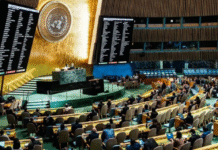After Savar, the ability to manage a post-disaster situation has raised serious concerns
On April 24, 2013, Rana Plaza, an eight-storied commercial building, collapsed in Savar. On May 13, after 21 days of the incident, the search for the dead ended with the death toll of 1,136. Approximately 2,515 injured people were rescued from the building alive. It is considered to be the deadliest garment-factory accident in history, as well as the deadliest accidental structural failure in modern human history.
According to BGMEA source, at the time of the collapse, five garment factories were in operation in the Rana Plaza building, total 2,760 workers were deployed in five factories of the building while the numbers are 3,900 as per reports by other sources.
The newspaper report said warnings to avoid using the building after cracks appeared the day before had been ignored. Garment workers were ordered to return the following day and the building collapsed during the morning rush-hour.
Why the building collapsed?
According to an assessment report of the Asian Disaster Preparedness Centre (ADPC, 2013), the column sizes of Rana Plaza were comparatively small, compared to a standard 8-9 storied industrial building, which might have facilitated the sudden collapse. Storage of heavy equipment in the upper floors, poor workmanship and use of low-strength materials all contributed to the collapse.
The ill-constructed building was built on marshy land filled in with garbage and loose soil. The collapse followed reports of trembling from nearby buildings, giving an eerie sense of the low-lying areas on which the surrounding community stood. Following the tragedy, it was also alleged that Rana Plaza was constructed according to a faulty design, using poor quality of construction materials and violating the rules of law.
Search and rescue operations, vulnerability of Dhaka and our capacity
Rana Plaza collapse foretastes the preparedness of government and other relevant service providing agencies including factory owners for a tremor. A single building collapse killed 1,136 people and wounded more than 2,000 workers while government’s “all out action” took around 21 days for completing the search and rescue operation.
Logically, curiosity grows: if a moderate tremor hits the country and collapses thousands of buildings, then how long will the government take to finish their search and rescue operation with this minimum extent of preparation along with huge gaps in equipment stock.
It is predicted that Dhaka – one of the most populous mega cities in the world – will face a series of disasters in coming years due to destruction of city environment caused by its rapid growth of unplanned urbanisation and lack of good governance. According to the sources, the city will become fifth largest city by 2030 in terms of population. Dhaka city is also at high risk due to earthquakes. According to the earthquake disaster risk index, Dhaka is most vulnerable among the 20 most vulnerable cities in the world.
Quakes in Bangladesh
Earthquake is a major threat to urban environments. Although Bangladesh has not experienced a major earthquake in over a century, recently an escalation in seismic activity has been observed. But, a strong earthquake of 8.6 magnitude occurred in Assam on August 15 in 1950, killing 1,526 people. Another 8.1 magnitude quake hit Assam on June 12 in 1897, killing 1500 people. The casualties were less because of low density of population and fewer numbers of concrete structures at that time.
The observatory at BUET recorded 86 tremors of over 4 magnitude during January 2006 to May 2009. These minor tremors indicate the possibility of much more powerful earthquakes hitting the country. According to a seismic zoning map (BUET), 43% area in Bangladesh can be rated high risk, 41% moderate and 16% low.
The high risk group includes major population belts such as Chittagong, Dhaka, Rangpur, Bogra, Mymensingh, Comilla, Rajshahi and Sylhet. An Oxfam study in 2002 shows there were more than 130 instances of minor seismic disturbance during 2007–2009. Eight tremors with magnitude of 4 on the Richter scale occurred during 2000–2010.
Capital trouble
Bangladesh is situated at a high risk earthquake prone zone and an unprecedented human disaster may occur in the country anytime for even a moderate to heavy tremor. A powerful earthquake needs at least 100 to 150 years to originate in a particular region and in that sense it is overdue for Bangladesh and parts of Assam, as 112 years have passed by since a heavy tremor from Dawki Fault hit the region.
Dhaka is more vulnerable to earthquakes due to its geological location and both human and economic exposure. According to CDMP study, some 78,323 buildings will be destroyed completely if a 6 magnitude earthquake shakes Dhaka. In case of a 7.5 magnitude earthquake, some 72,316 buildings in the capital will be damaged totally and 53,166 others partially while the numbers will go up to 238,164 across the country in case of an 8.5 magnitude tremor.
There would be an economic loss of about Tk8,580 crore resulting from only structural damage in case of a 7.5 magnitude earthquake. The loss would be Tk8,346 in case of 6-magnitude earthquake if the epicentre is Dhaka city. Some 30 million tonnes of debris, equal to 2,880,000 truckloads (25 tonnes per truck), will be generated if a 6-magnitude earthquake jolts the city from beneath it. According to the study, at least 10 major hospitals, 90 schools in the capital will be destroyed completely and another 241 hospitals and clinics, 30 police stations and four fire stations partially in case of a 7.5-magnitude quake.
Best preparation for the worst
Considering the nature of an entire city’s vulnerability to earthquake, the government of Bangladesh has undertaken a number of initiatives to minimise the loss and damage caused by any possible disaster.
Analysing the seismic data, the government has already prepared the earthquake risk maps of Dhaka, Chittagong and Sylhet City Corporations and similar mapping projects are indeed underway for some of sub-regions. The Standing Orders on Disaster (SOD) has been updated in 2010 to identify the duties and responsibilities of the relevant ministries, departments and agencies to reduce disaster risk and damage.
The National Contingency Plan has already been prepared. The authority concerned is going to update the plan by formulating the contingency plans of the emergency response agencies like Fire Service and Civil Defence (FSCD), Armed Forces Division (AFD), Department of Disaster Management (DDM), and Cyclone Preparedness Programme (CPP) to address the post-disaster situation, including for earthquakes.
The Ministry of Housing and Public Works is working to enforce the Bangladesh National Building Code in constructing new structures to make the structures earthquake-resilient. The government launched an initiative under the Comprehensive Disaster Management Programme (CDMP) to build an emergency force of 62,000 community volunteers across the country to carry out rescue operations immediately after any disaster like earthquake.
The government has also taken a step to procure equipment under the “Procurement of Equipment for Search and Rescue Operation and Other Disasters” to carry out rescue operation immediately after disasters. It has already procured equipment worth Tk60 crore and handed them over to the concerned agencies.
Poor capacity to deal with quake
Although GOB took significant initiatives, considering the country’s vulnerability the government’s preparedness is far too inadequate to address its aftermath. Many risk factors like unplanned urbanisation remain. People have no proper knowledge about tremor and citizens have no idea what they have to do during one.
Under the CDMP, the government decided to build 62,000 community volunteers to carry out rescue operations immediately after an earthquake. But in four years since announcing the scheme, they could merely train a fraction – 12,000 – of the intended amount.
On the other hand, inefficiency and lack of coordination among the different government bodies and among GO-NGO is also considered as a big challenge. Debris management will become a serious challenge if tremor hits. A single building collapse (Rana Plaza) generated about 7,000 tonnes of debris and nearly 21 days were needed to complete the rescue operation.
If an earthquake like the 1897 one hit the country, about 300 million tonnes of debris will be generated and the first task would be to clear roads leading in and out of cities before any rescue drive could commence in earnest. A contingency plan is yet to be tested while Standard Operating Procedure (SOP) for the organisations, departments and the institutions yet to be developed.
More steps needed to face disasters
So the question remains – how prepared is the government to face possible worst-case scenarios following a disaster, such as an earthquake or a severe flood?
Involving different ministries and the non-government organisations, a coordination mechanism should be developed so that special guidelines could be prepared and disseminated, and extensive mass awareness programmes would be launched. The awareness programmes must span all strata of society including city dwellers, government officials, municipality officials, politicians, engineers, architects, designers, builders and medical people.
The government must enforce the Building Construction Act and the Building Construction Regulation in setting up new structures and stress the need for formulating a policy and nominate an authority to implement the Building Construction Regulation. Through the implementation of Bangladesh National Building Code (BNBC), casualties and the overall damage can be minimised.
Initiatives should be taken to demolish old and highly risky buildings as a first step towards minimising casualties in such natural disasters, followed by their retrofitting to make the vulnerable buildings earthquake-tolerant.
Recommendations
The collapse of Rana Plaza reminded us how fragile our buildings are. Learning from this tragedy, we may take the following steps to reduce the impact of a similar tragedy or even ones bigger in scale such as during an earthquake.
Ensuring proper implementation of Bangladesh National Building Code and its monitoring and implementation framework and mechanism as well as establishing proper authority to oversee the implementation.
Increase the capacity of emergency response agencies in skills and equipment as well as their structure, responsibilities and coordination mechanism along with proper-regular financial allocation.
Disaster risk reduction (DRR) measures should be institutionalised in every government institution at every level, especially in the urban context.
Government should emphasise greater involvement of public and private sector on implementing DRR measures.
Increase disaster preparedness and awareness capacity of the communities where media could play an important role along with other related stakeholders.
Finally, we never expect these sorts of accident or any major earthquake anywhere but preparedness, awareness and governance could contribute, reducing the loss of lives and property.
Source: Dhaka Tribune










